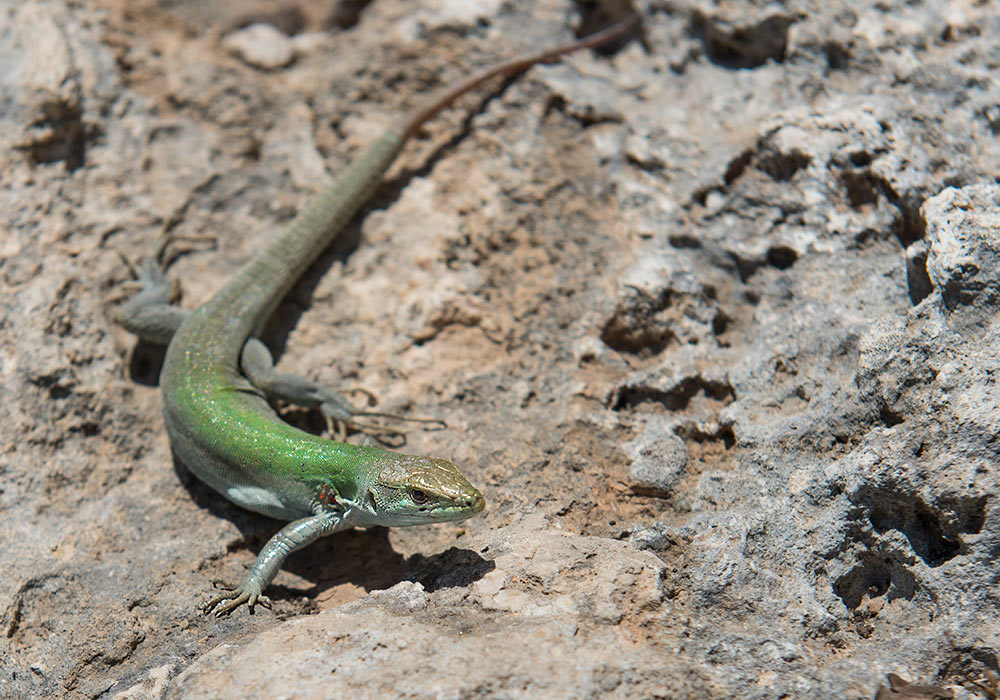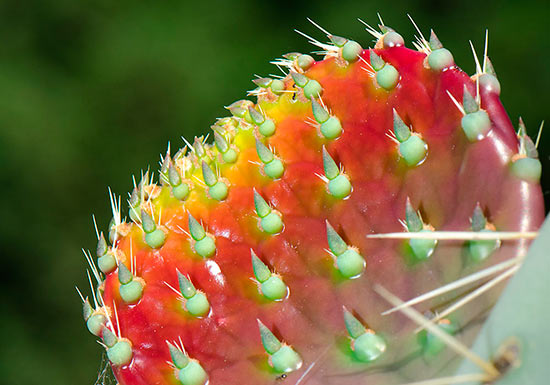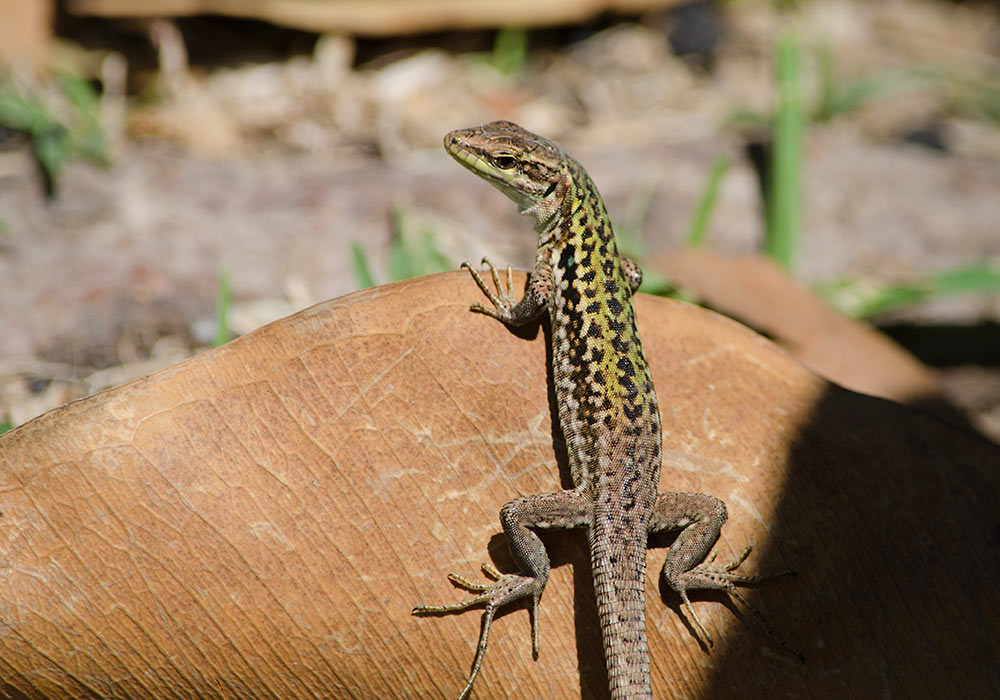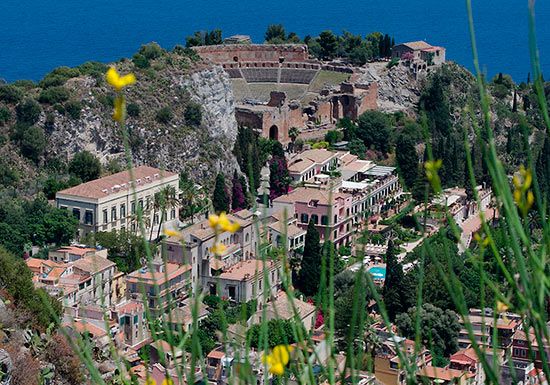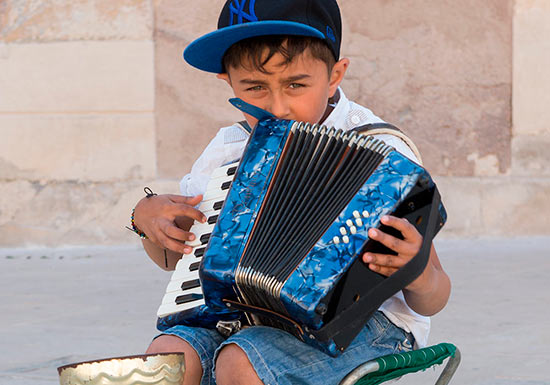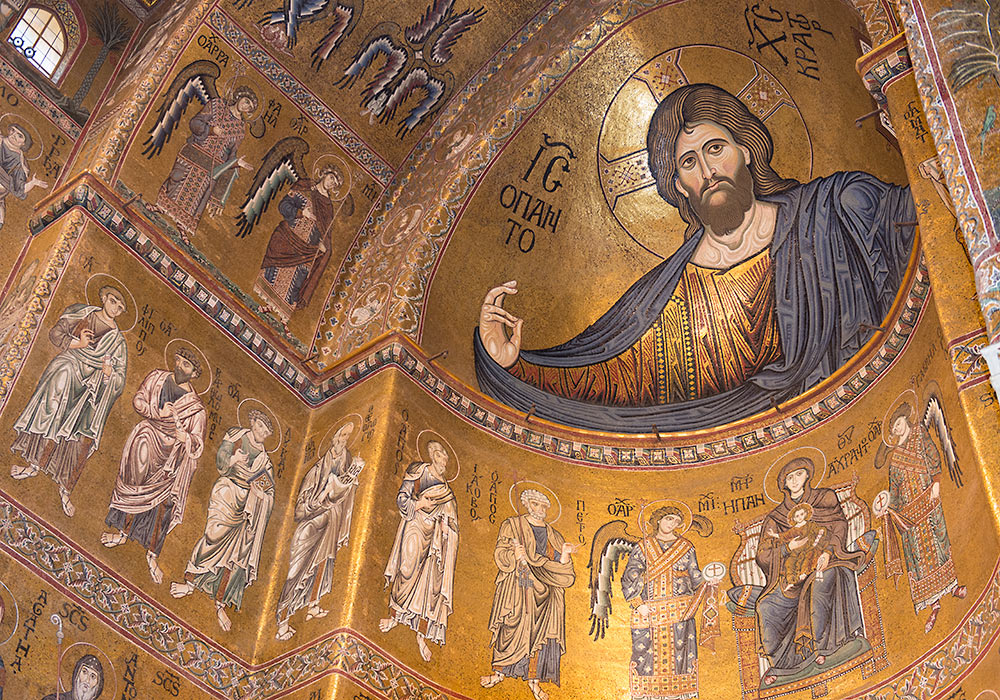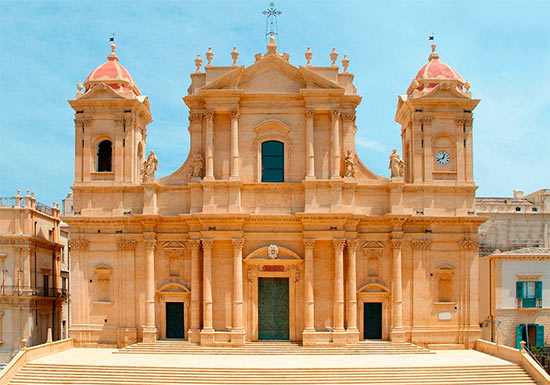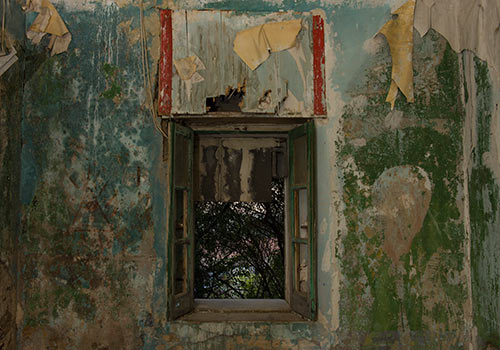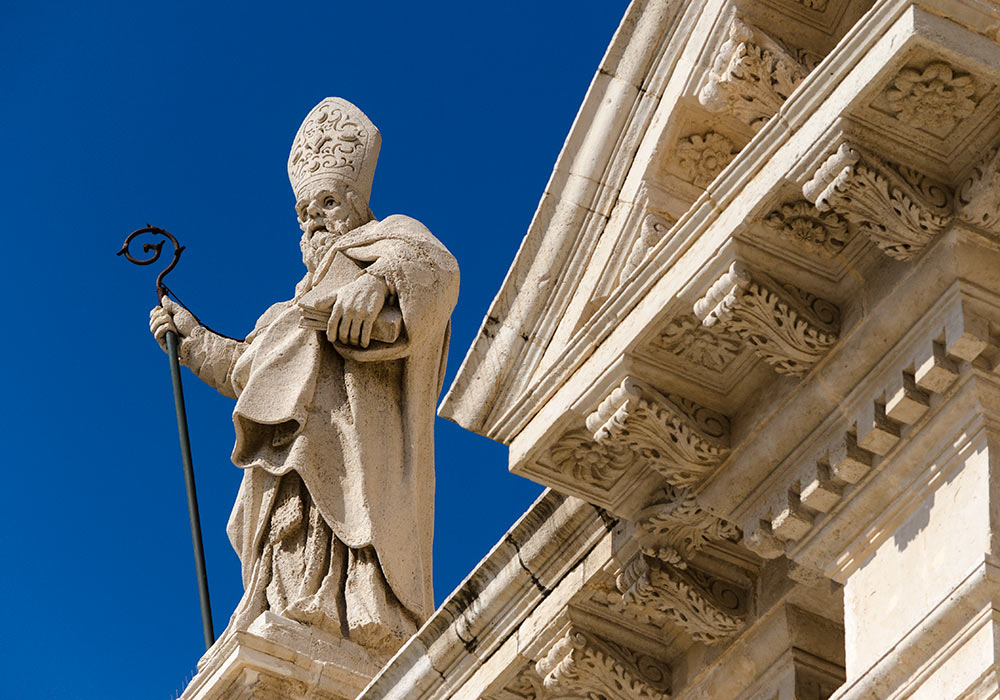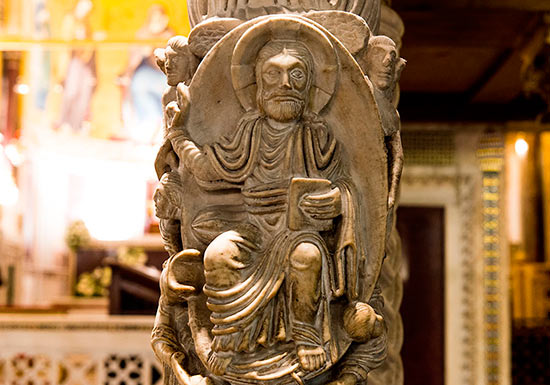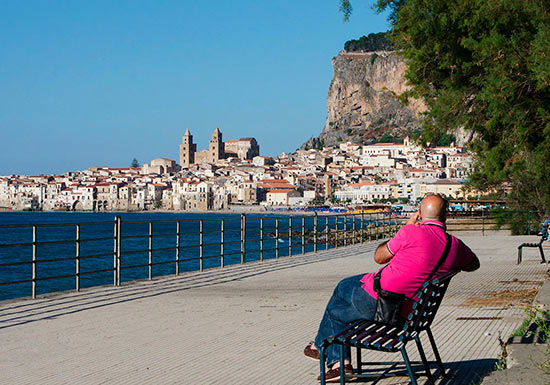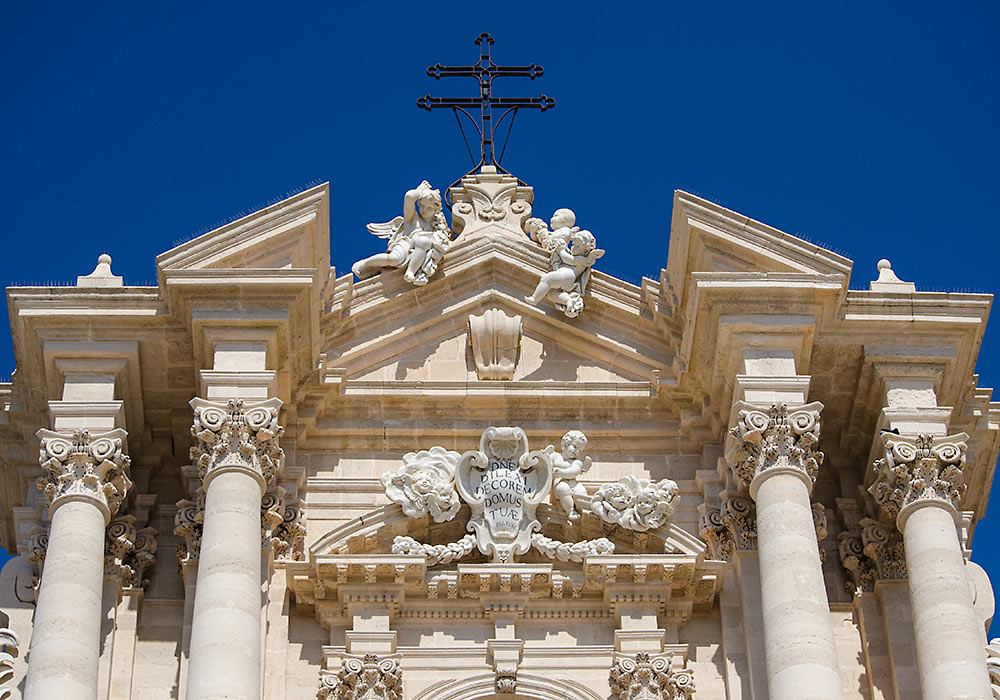The Archeological Park in Syracuse (Siracusa)
Siracusa - a historic city, the capital of the province of Siracusa.
The Archeological Park in Siracusa
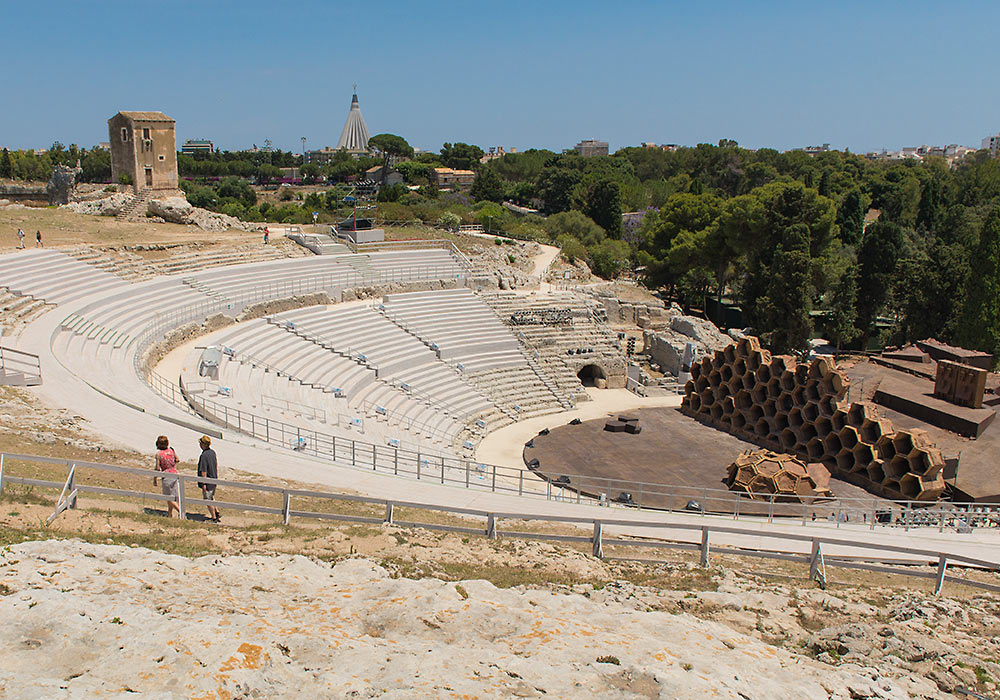
The Greek theatre in the Archeological Park, one of the most celebrated of all the ruins of Siracusa. With its 138 metre in diameter, it is the largest Greek theatre in Sicily. To the right you see preparations for the evening's performance of Verdi's Aida.
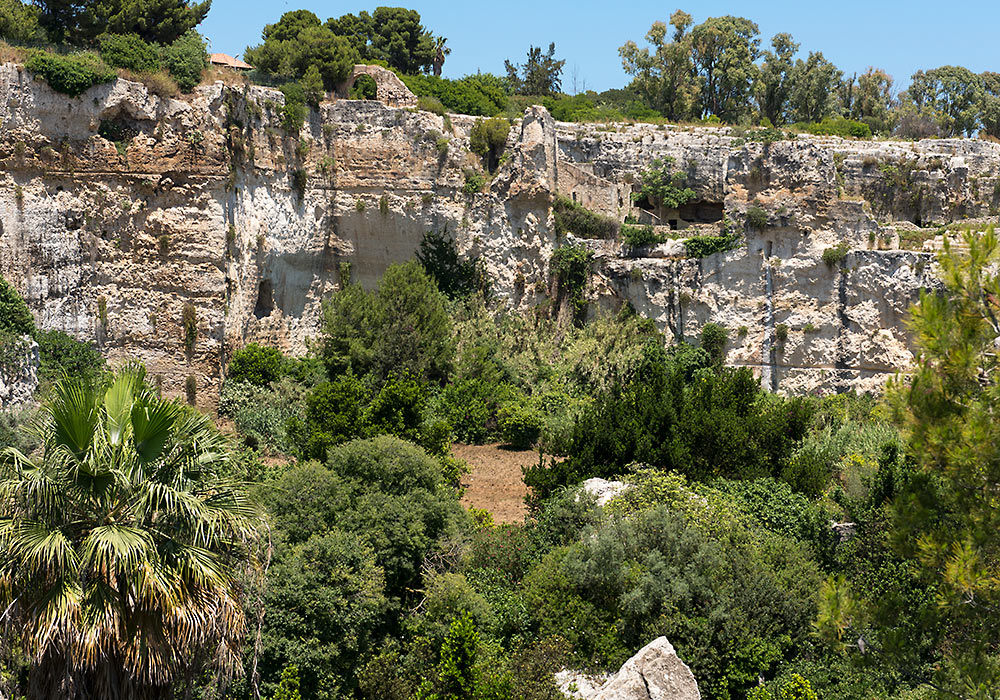
The Latomie of Syracuse is the limestone quarries later used for prisons. Now it is a tropical garden full of local and exotic plant species. The main attractions are the grottos Ear of Dionysos (Orecchio di Dionisio) and Grotta dei Cordari (now closed for security reasons).
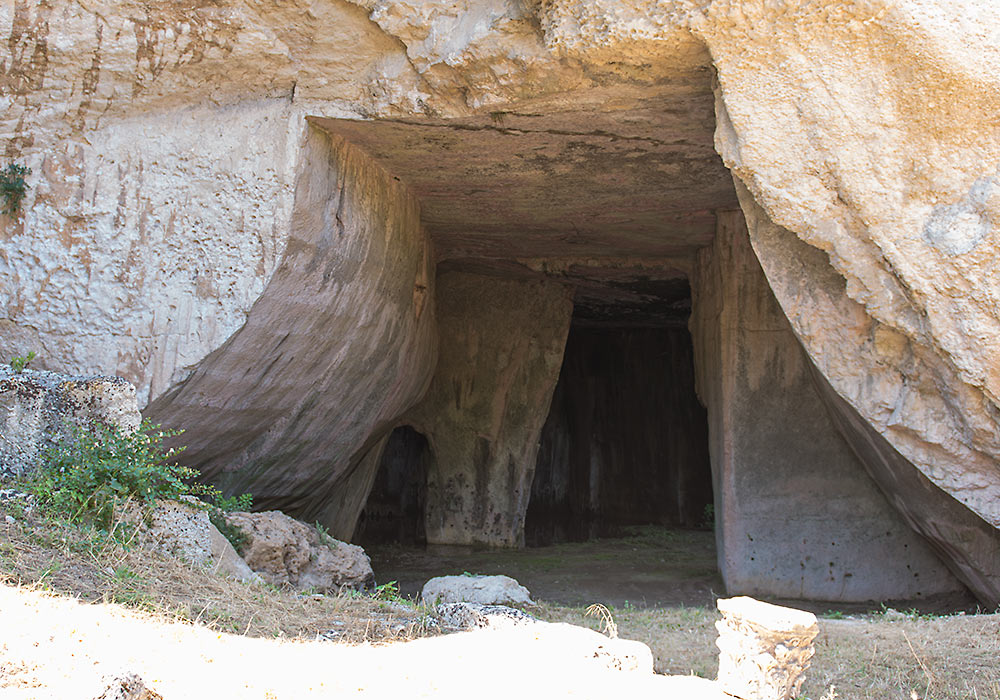
Grotta dei Cordari (the ropemaker's grotto) – now closed for security reasons. Ropemakers worked here for centuries.
Winston Churchill visits Syracuse in 1955
Sir Winston Churchill On Holiday (1955)
The Ear of Dionysos (Orecchio di Dionisio)
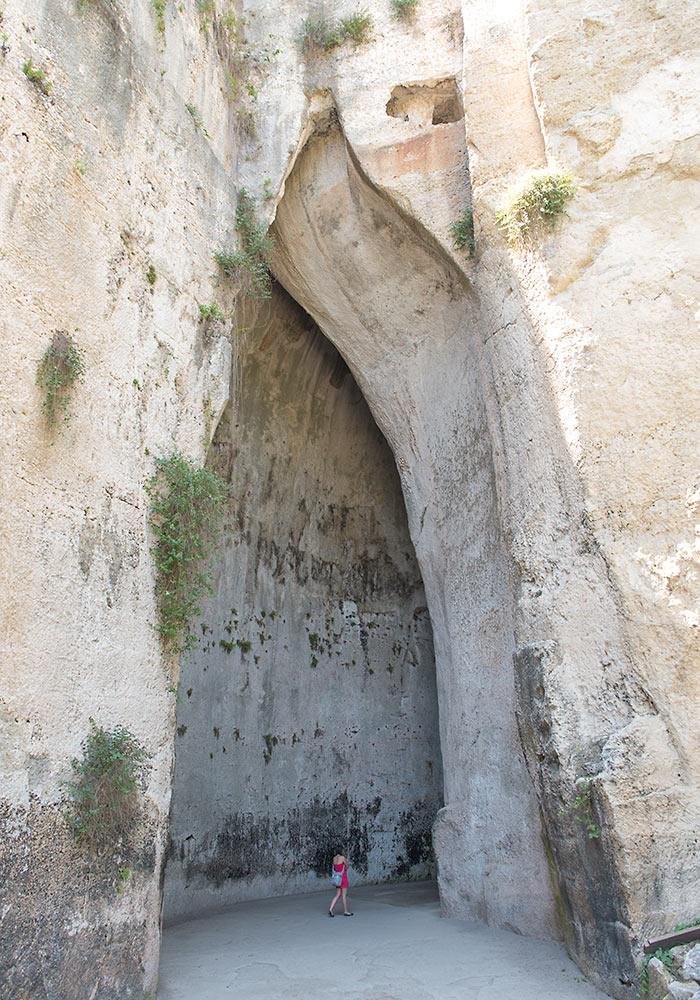
The entrance. It was Caravaggio that gave this artificial grotto its name in (1608).
The Ear of Dionysos (Orecchio di Dionisio)
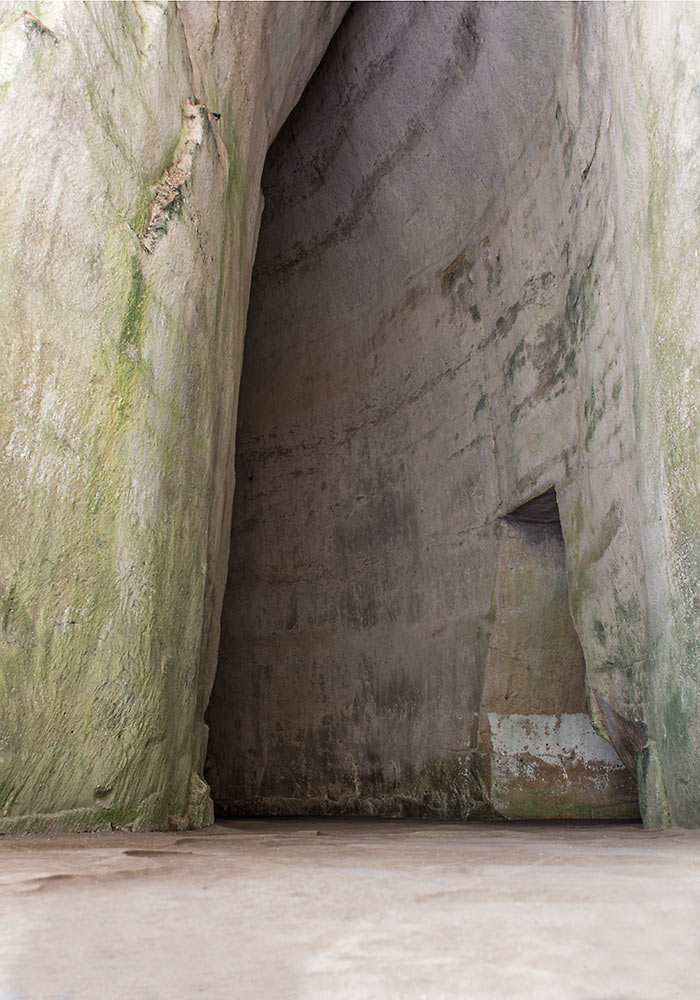
Inside. It is actually quite dark inside, but this photos is taken with long shutter speed.
The Ear of Dionysius is 23 metres high and extends 65 metres back into the cliff. The cave has very good acoustics – try when you visit it!
The Ear of Dionysius was dug in Greek/Roman times as a water storage for Siracusa.
The name of the cave was coined in 1608 by the painter Caravaggio. It refers to the tyrant Dionysius I of Syracuse. According to legend, Dionysius used the cave as a prison for political dissidents, and by means of the perfect acoustics eavesdropped on the plans and secrets of his captives.
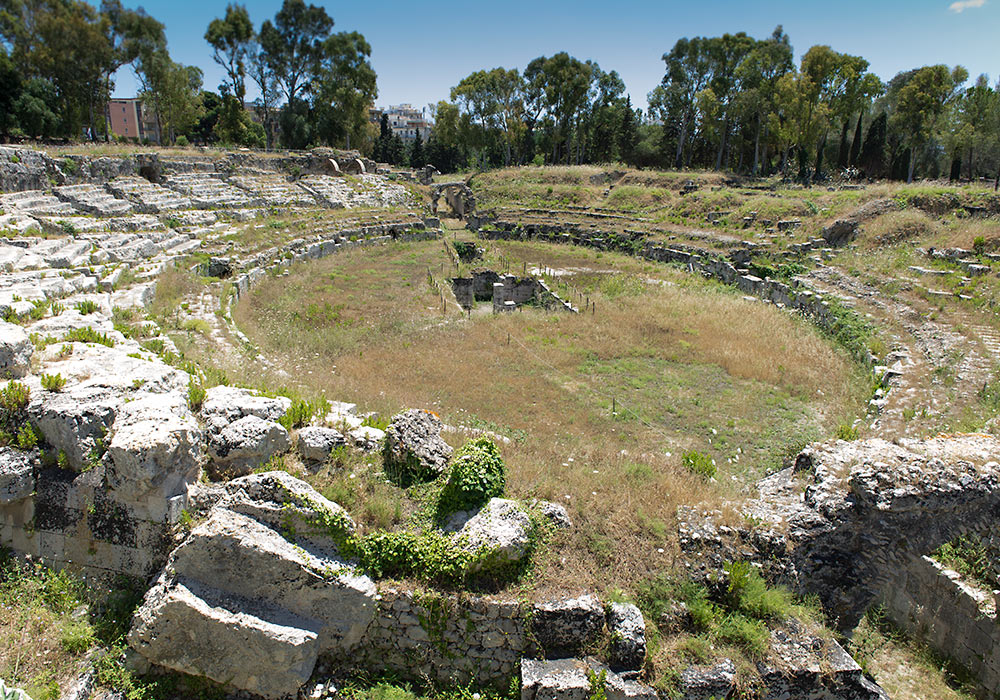
The Roman amphitheatre in Syracuse (140m by 119m). It was used for gladiator fights. The rectangular depression was probably for the machinery used in the spectacles.
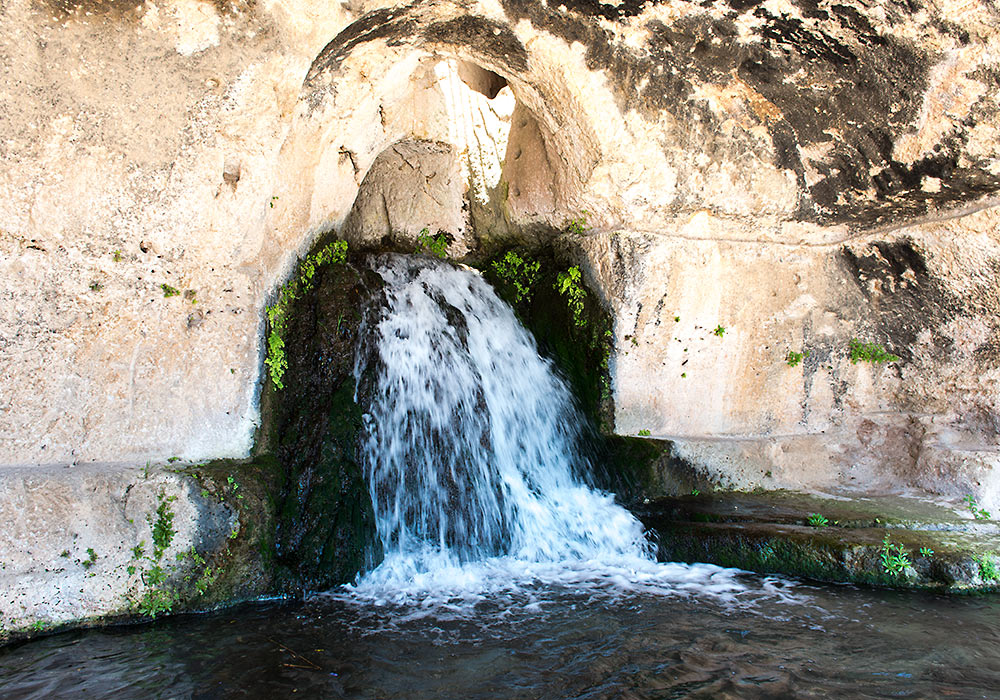
Grotta del Museion.
Sicilian Sites on UNESCO's World Heritage List
- Agrigento: Archaeological Area of Agrigento (UNESCO)
- Aeolian Islands: Isole Eolie. The group consists of seven islands (Lipari, Vulcano, Salina, Stromboli, Filicudi, Alicudi and Panarea) and five small islets (Basiluzzo, Dattilo, Lisca Nera, Bottaro and Lisca Bianca) in the vicinity of Panarea. (UNESCO)
- Caltagirone (UNESCO)
- Catania (UNESCO)
- Cefalù Cathedral
- Militello Val di Catania (UNESCO)
- Modica (UNESCO)
- Monreale Cathedral
- Mount Etna (UNESCO)
- Noto (UNESCO)
- Palermo: Palazzo dei Normanni (The Norman Palace)
- Palermo: Cappella Palatina (The Palatine Chapel in the Norman Palace)
- Palermo: Church of San Giovanni degli Eremiti
- Palermo: Church of Santa Maria dell'Ammiraglio (also known as the Martorana)
- Palermo: Church of San Cataldo
- Palermo: Cathedral of Palermo
- Palermo: The Zisa Palace (La Zisa)
- Palermo: The Cuba Palace (La Cuba)
- Palazzolo Acreide (UNESCO)
- Ragusa (UNESCO)
- Scicli (UNESCO)
- Syracuse and the Rocky Necropolis of Pantalica (UNESCO)
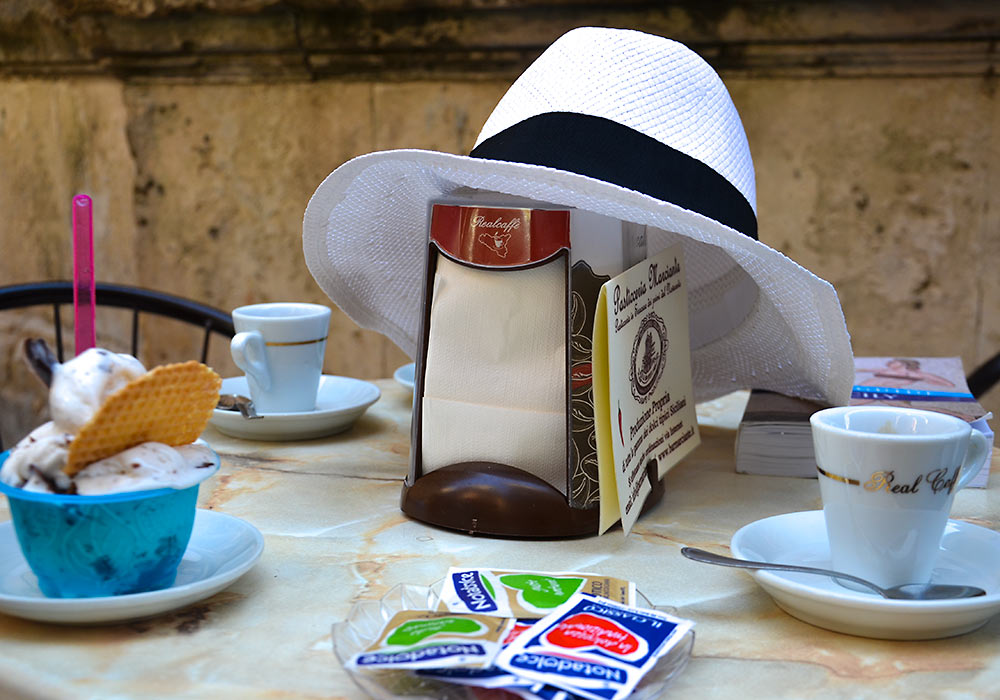
And finally an espresso.
Photo: Torild Egge
The distance between Siracusa and some other cities in Sicily
Siracusa-Agrigento 217 km
Siracusa-Catania 66 km
Siracusa-Cefalù 249 km
Siracusa-Modica 72 km
Siracusa-Noto 38 km
Siracusa-Palermo 277 km
Siracusa-Ragusa 90 km
Siracusa-Taormina 118 km
Siracusa-Trapani 375 km
Here you'll find more photos from Sicily:
Sicily: Some geographical names in Italian, Sicilian, English, Latin, Arabic and Greek
- Agrigento (Sicilian: Girgenti, Ancient Greek: Akragas (Ἀκράγας), Latin: Agrigentum, Arabic: Kirkent or Jirjent)
- Agrigentum, Latin for Agrigento
- Akragas (Ἀκράγας), Ancient Greek for Agrigento
- Àsaru, Sicilian for Assoro
- Assorus, Latin for Assoro
- Assoros, Greek for Assoro
- Baarìa, Sicilian for Bagheria (also the title of a film by Giuseppe Tornatore)
- Balad al-fīl ("the Village (or Country) of the Elephant"), one of the Arabic names for Catania
- Balarm, Arabic for Palermo
- Butirah, Arabic for Butera (one of the largest cities in Arab Sicily)
- Càccamu Sicilian for Caccamo
- Castrogiovanni (until 1926 Enna was known as Castrogiovanni)
- Castrugiuvanni, Sicilian for Enna
- Cefalù (Sicilian: Cifalù, Greek: Κεφαλοίδιον, Diod., Strabo, or Κεφαλοιδὶς, Ptol.; Latin: Cephaloedium, or Cephaloedis)
- Cephaloedium or Cephaloedis, Latin for Cefalù
- Cifalù, Sicilian for Cefalù
- Egesta, Greek for Segesta
- Enna (Sicilian: Castrugiuvanni; Greek: Ἔννα; Latin: Henna and less frequently Haenna). Until 1926 the town was known as Castrogiovanni.
- Gibilmanna: The name 'Gibilmanna' derives from Arabic 'gebel / jebel' (mountain) and 'manna' (edible substance extracted from the manna ash trees).
- Girgenti, Sicilian for Agrigento
- Henna / Haenna, Latin for Enna
- Hyspicae Fundus, Latin for Ispica
- Ispica (Sicilian: Spaccafurnu, Latin: Hyspicae Fundus)
- Jirjent, Arabic for Agrigento (also: Kirkent)
- Kefaloidion or Kefaloidis (Κεφαλοίδιον / Κεφαλοιδὶς), Greek for Cefalù
- Kentoripa, ancient Greek for Centuripe
- Kirkent, Arabic for Agrigento (also: Jirjent)
- Madīnat al-fīl ("the City of the Elephant"), one of the Arabic names for Catania
- Noto (Sicilian: Notu; Latin: Netum)
- Notu, Sicilian for Noto
- Netum, Latin for Noto
- Palermo (Sicilian: Palermu, Latin: Panormus, from Greek: Πάνορμος, Panormos, Arabic: Balarm, Phoenician: Ziz)
- Palermu, Sicilian for Palermo
- Panormos (Πάνορμος), Greek for Palermo
- Panormus, Latin for Palermo (from Greek: Πάνορμος, Panormos)
- Qaṭāniyyah, allegedly from the Arabic word for the "leguminous plants"
- Sarausa, Sicilian for Siracusa
- Selinous, Greek for Selinunte
- Selinus, Latin for Selinunte
- Siggésta, Sicilian for Segesta
- Siracusa (English: Syracuse, Latin: Syracusæ, Ancient Greek: Syrakousai (Συράκουσαι), Medieval Greek: Συρακοῦσαι, Sicilian: Sarausa)
- Spaccafurnu, Sicilian for Ispica
- Syracuse, English for Siracusa
- Syracusæ, Latin for Siracusa
- Syrakousai (Συράκουσαι), Ancient Greek for Siracusa
- Syrakousai (Συρακοῦσαι), Medieval Greek for Siracusa
- Taormina (Sicilian: Taurmina, Greek: Ταυρομένιον Tauromenion, Latin: Tauromenium)
- Taurmina, Sicilian for Taormina
- Tauromenion (Ταυρομένιον), Greek for Taormina
- Tauromenium, Latin for Taormina
- Terranova is the old name for Gela (the fifth largest town in Sicily)
- Ziz, Phoenician for Palermo

